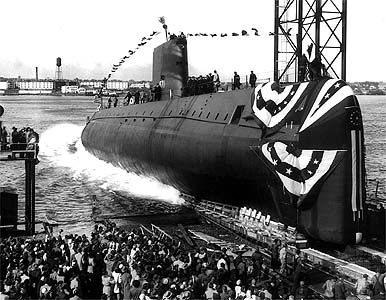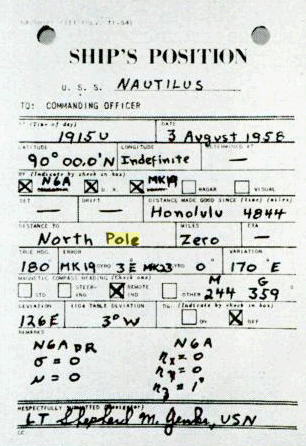This Week in Maritime History, July 31-August 6

July 31, 1715
Hurricane Sinks 10 Spanish Treasure Ships
On the east coast of Florida, a hurricane struck on July 31st, 1715 sending 10 Spanish treasure ships into the depths of the ocean, and claiming the lives of nearly 1,000 people. The treasure ships took large quantities of gold and silver with it, which remained partially unclaimed in underwater shipwrecks for 250 years.
In the early 1700’s, Spain often sent their fleets to the West to retrieve natural resources for the country, especially silver and gold. While the ships were well-equipped for enemy forces, nothing could save the ill-fated ships from unwavering weather conditions.

PHOTO CAPTION: Painting of 16th century Spanish ships.
In 1715, Spanish ships were leaving Havana, Cuba with 120 tons of gold and silver coins. They stayed close to the Florida coast as per normal protocol. However, within a week, a massive hurricane breached the Florida waters wrecking the resource-laden vessels into the ocean one by one, taking anywhere from 700-1,000 victims.
August 2, 1943
American WWII PT-109 Attacked, JFK Becomes War Hero
In the midst of WWII, Japanese air support had been on a hunt for U.S. PT boats in order to safely send their destroyers to Kolombangara Island to disperse war supplies to troops. Rightfully, the Japanese saw the American torpedo boats protecting the Solomon Islands as a threat to the fate of their destroyer ships and ordered for aerial searches of PTs.
The Japanese Amaqiri destroyer rammed the PT-109 early on August 2nd, 1943, splitting the Naval Vessel in two pieces. The ship was decimated, and the impact killed 2 of the crewman. Damage was so extensive that nearby American PTs assumed the entire crew was killed, However, the other 11 crew members, including John F. Kennedy, were alive and clinging to floating debris in the Pacific ocean.

PHOTO CAPTION: Lieutenant John F. Kennedy, USNR, (standing at right) with other crewmen on board PT-109.
Kennedy and crew managed to swim to a coral island to seek refuge. Upon reaching land, Kennedy decided to swim back out to sea in hopes to flag down an American vessel. The return swim nearly killed Kennedy due to his chronic back condition and strong currents. The PT-109 remaining crew eventually swam to a larger island nearby, presumed to be Nauru Island. Kennedy met up with natives who agreed to carry a message south for the Americans. He carved a distress message into a coconut giving his believed vacation, his ability to pilot, and how many stranded crew there were. Despite his location being incorrect (the crew was on Cross Island, not Nauru), the message reached an American Lieutenant and a small boat was sent to take the men to a nearby island with American forces.
Kennedy was awarded a Navy and Marine Corps. medal. The coconut made a home in the Oval Office.
August 3, 1492
Columbus Sets Sail to the West
Italian explorer, Christopher Columbus, set sail from the Spanish port of Palos on August 3rd, 1492. Columbus was in command of three ships, the Nina, the Pina, and the Santa Maria for an exploratory voyage to locate a western sea route to reach India, China, and “spice islands” in Asia.
Months after embarking, Columbus and crew spotted land in the Caribbean waters, claiming land of the Bahamas and mistaking the islands for China and Japan. They established a colony on Hispaniola, which the men believed to be Japan.
Following their occupation, Columbus made a return journey to Spain with gold, spices, and captives in 1493. He was received with the highest honors, and is the first European to explore the Americas since the Vikings in the 10th century, and continued to make more expeditions for Spain.

PHOTO CAPTION: Christopher Colombus map, c.1490
Though he never accomplished tracking a shipping route to Asia, Columbus’ forever has a place in history for discovering the New World for Europe.
August 3, 1958
USS Nautilus Completes First Undersea Voyage to the North Pole
The USS Nautilus was the first nuclear submarine, the first vessel to reach the geographic North Pole underwater, and pioneered a new, shorter shipping route from the Pacific to the Atlantic and Europe.
 PHOTO CAPTION: Launch of the USS Nautilis
PHOTO CAPTION: Launch of the USS Nautilis
Designed by a Russian-born engineer who the U.S. added to their atomic program in 1946, the Nautilus was a giant endeavor for science and for the military. Despite the skeptics, the Nautilus was developed and delivered as the world’s very first nuclear-propelled submarines years ahead of schedule in 1952.
With a relatively larger size than diesel-electric subs, the 319-ft Nautilus was a feat of engineering, being able to remain submerged virtually indefinitely due to the atomic engine, and very little amounts of nuclear fuel needed to keep it running instead of air. The uranium-powered Nautilus could travel underwater at speeds exceeding 20 knots and broke many submarine travel records in its first years in service of the Navy.
In 1958, the Nautilus was dispatched for a mission to cross the North Pole. The submarine holstered a crew of 116, including officers, crew and scientists. In a matter of weeks, the Nautilus steered through the Bering Strait, staying underwater until it reached Alaska. The sub then left the coast of Alaska, and slipped under the Arctic ice cap, about 500-feet beneath the surface.

PHOTO CAPTION: Nautilus, 90N, 19:15, 3 August 1958, zero to North Pole
On August 3rd, 1958, the Commander of the Nautilus announced to his crew that the Nautilus had passed under the geographic North Pole, without stalling. He proclaimed the milestone for the world, for his country, and for the Navy.
Upon the return of the historic journey, Commander Anderson was awarded a Legion of Merit from President Eisenhower, and on March 3, 1980, the Nautilus was designated a National Historic Landmark after a 25-year and 500,000 mile career.
August 6, 1862
Civil War Ship C.S.S. Arkansas is Blown Up by Crew
The C.S.S. Arkansas was an ironclad warship belonging to the Confederates during the American Civil War servicing the Mississippi River. The 165-feet long and 35-feet wide Arkansas only lasted for 23 days before meeting its demise.

PHOTO CAPTION: Sepia wash drawing by R.G. Skerrett. From the US Naval Historical Center courtesy of the Navy Art Collection.
After successfully battling and running off Union ships in July, the Arkansas had sustained damage to her engines. Still she pressed on, and on August 3rd, 1862 was ordered to Baton Rouge to assist Confederate operations. The Arkansas suffered more engine problems, and even ran aground. While the Arkansas was out of commission, the Union enemy ship, the U.S.S. Essex steamed forward to meet the Arkansas for battle.
The Arkansas crew got the ship sailing, but she suffered a propeller shaft breakage, leaving the vessel helpless, run aground once more, and with impending defeat from the Essex. In order to prevent Union capture, the crew of the Arkansas ordered for the engines to be broken up, the guns loaded, and shells spread around. They then set the ship ablaze. The ship drifted and then blew up among the attacking fleet of the Union.
The C.S.S. Arkansas currently resides deep under a levee and left service undefeated in her short military career.
